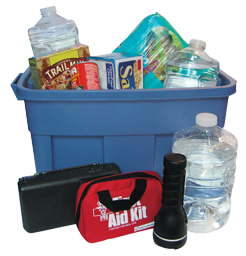
Whether you are returning home after a disaster or are volunteering to help, there are some important things to think about and prepare for before heading to the site. First, safety! Before you enter the home or other structure, check for gas leaks and damage to the electrical lines. If gas is leaking or the power lines are damaged, do not enter the home/structure.
If you are volunteering, ask! Ask what is needed. Do not bring donations that have not been requested, such as clothing, toys, appliances, etc. Donations require sorting and storage, which can be more of a problem than a help in the early stages of clean up.
Here are some of the supplies you are likely to need (or that you can volunteer to supply). When cleaning after a flood or damaging storm, you will need general cleaning supplies, other supplies for making minor repairs, and personal items.
Cleaning supplies (and suggested quantities for cleaning a home):
- Air freshener, 8- or 9- ounce can
- Bleach, 82 ounces
- Bucket, 5-gallon, with lid
- Cleaner, household, 12- to 16-ounce bottle
- Clothes pins, 50
- Clothesline, 100 feet
- Detergent, liquid laundry, 50 ounces
- Disinfectant dish soap, 16- to 28-ounce bottle
- Gloves, latex, 2 pairs
- Gloves, work, 1 pair
- Masks, N-95 rating, 5
- Scouring pads, 5
- Scrub brush
- Sponges, 7
- Towels for cleaning, 18
- Trash bags, heavy-duty, 33- to 45-gallon, 24-bag roll
Tools:
- Ax
- Chain saw for clearing trees
- Hacksaw for cutting metal and PVC (such as pipes)
- Hammer and nails
- Pliers, Phillips and flathead
- Screwdriver
- Wrench
- Rope
First aid kit:
- Aspirin
- Bandages, adhesive
- First aid booklet
- Gauze
- Gloves, sterile, 2 pairs
- Ointments, antibiotic and burn relief
- Soap
- Sunscreen, SPF 30
- Thermometer
- Wipes, antibiotic
Food, water, and snacks:
- Water (at least 1 gallon per person per day) If you have no running water, buy foods that require little or no water in preparation. Choose low-salt foods to help minimize thirst. Many foods need no cooking, such as:
- Breakfast cereal
- Granola bars
- Cookies
- Crackers
- Jerky
- Ready-to-eat meats in cans or pouches
- Canned vegetables
- Peanut or another nut butter
- Trail mix
- Canned meals such as spaghetti/pasta
- Banned infant formula
- Baby/toddler foods in jars
- Hard candy (Note: Hard candy will help keep the mouth moist if water
supplies are limited). - Take vitamins if you have them.
- Buy nonperishable (dry) foods for your pets.
Open only as much of these foods as you will need for one meal to avoid the need for refrigeration. Choose foods that your family will eat during this stressful time. Be sure everyone eats enough to remain healthy.
Food storage and preparation supplies:
- Manual can opener
- Metal pans and cooking utensils for cooking on a fire or grill
- Aluminum foil and plastic wrap
- Plastic forks, knives, and spoons
- Paper napkins and plates
- Storage bags for food
- Paper towels
- Garbage bags for disposing of trash
- Ice chest (ice will probably be available at an emergency
supply distribution center)
Personal hygiene items:
- Hand sanitizer, alcohol based
- Soap
- Toothbrush
- Toothpaste
- Towel for bath
- Washcloth
Other important items to remember:
- Medications, prescriptions
- Insect repellant that contains DEET
- Sturdy shoes (with toes and hard soles)
- Tarp, to cover roof damage or use as an outdoor shade
Sources: Texas AgriLife Extension Service (2017). After a disaster: How to recover, Publication E-300, 2/11. https://texashelp.tamu.edu/wp-content/uploads/2016/02/B6203-after-a-disaster.pdf, Retrieved August 31, 2017.
Texas AgriLife Extension Service (2017). Returning home after a disaster: Supply list. Retrieved August 31, 2017.
